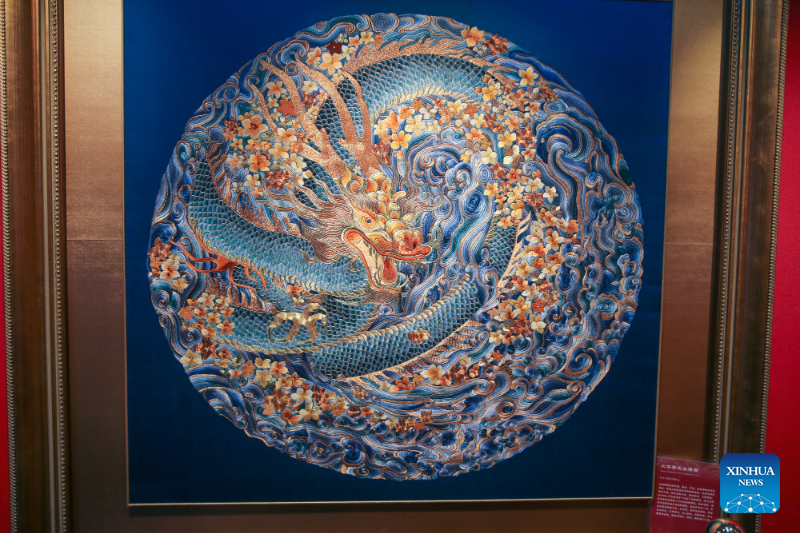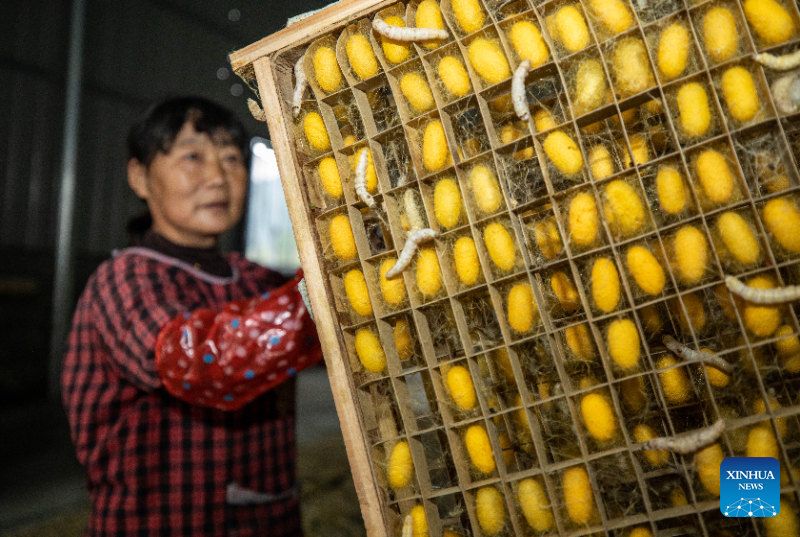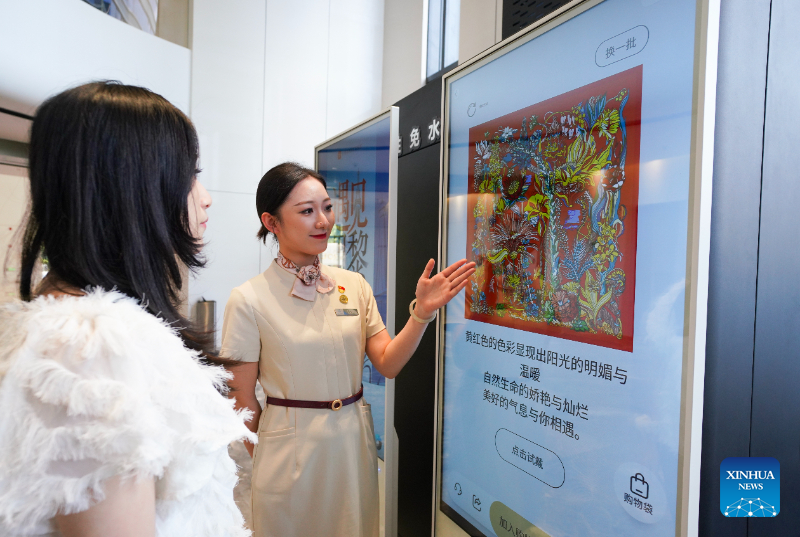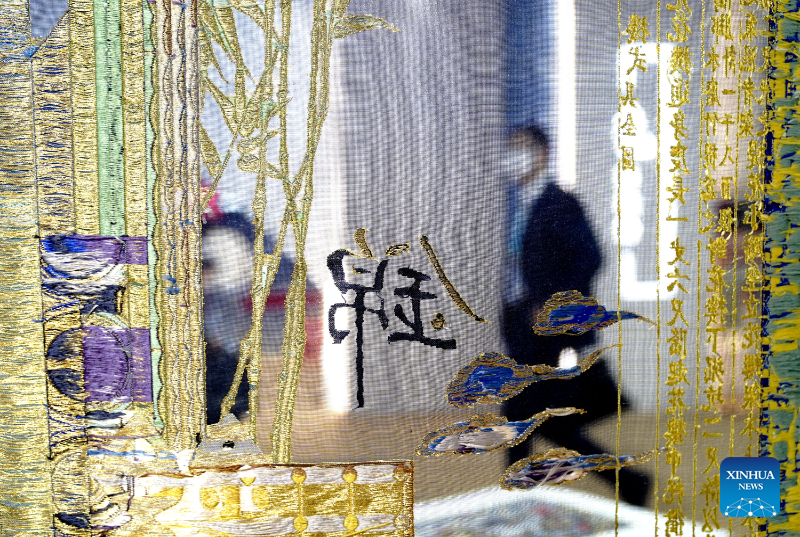Golden cocoon reborn: the resplendent transformation of China's silk industry
Source: Xinhuanet
Editor: huaxia
2025-06-26 10:58:57

This photo taken on Nov. 26, 2024 shows a Beijing Embroidery artwork of Jin Xin displayed at an exhibition hall of Beijing Embroidery in Beijing, capital of China.(Xinhua/Zhu Weixi)
By Liu Jiawen, Yang Dingdu, He Yuan
HANGZHOU, June 26 (Xinhuanet) -- Chinese silk, the radiant thread of the ancient Silk Road, once adorned emperors and bridged cultures. Synthetic fibers and mechanized textiles later dimmed its luster, leaving mulberry groves silent.
Now, golden cocoons from laboratories revive rural fields. Biotechnology, AI, and eco-friendly dyeing propel China's silk industry into a vibrant renaissance, soaring from villages to global stages.
Rural Revival: From Decline to Prosperity
In Xidong Village, Huabu Town, Kaihua County, Zhejiang Province, sericulture sustained families for generations. In the 1970s, silk income built homes, and mulberry groves thrived.
By 2016, white cocoon prices fell below 15 yuan per jin—about $4.20 per kilogram—below production costs. Youth left for cities. "The village grew eerily quiet, mulberry trees untended," recalls Xu Yifeng, Xidong Village Party Branch Secretary.
In 2017, Xu met Tu Hongyan, Chairman of Hangzhou Wensli Group, at a Zhejiang Women's Federation conference. She pitched Xidong's 560-acre mulberry groves, asking, "Can you help us prosper?"
In 2018, Wensli and Zhejiang University introduced "Golden Silkworm No. 1" cocoons to Xidong, launching a large-scale pilot. Tu's team provided technical training and guaranteed purchases, drawing villagers back.

A silk farmer shows a cocoon frame in Xidong Village of Kaihua County, east China's Zhejiang Province, Oct. 21, 2020. (Xinhua)
On October 21, 2020, farmers displayed golden cocoons. Their natural golden hue, needing no dye, offers antioxidant and antibacterial properties for premium silk. "The silk gleamed like gold thread—stunning!" Xu says.
The village built an 800-square-meter silkworm nursery and 3,300-square-meter breeding sheds. Mechanized systems and climate controls boosted quality.
Households now earn an extra 30,000 yuan ($4,200) yearly. The village collective gains 450,000 yuan ($63,000) annually. Golden cocoons are Xidong's "golden password," reflecting a national silk revival.
Technology's Touch: Redefining the Silk Chain
Golden cocoons signal a technological leap. Biotechnology, AI, and green dyeing shift silk from high-pollution to high-value.
In 2021, Wensli established an AIGC laboratory. By 2023, it launched the world's first textile-specific AI pattern model with over 700,000 designs and 300+ algorithms, offering 10^27 permutations—enough for 100,000 unique scarves per person globally. "Designing took days; now it's seconds, personalized," says Ma Tingfang, Vice General Manager of Hangzhou Wensli Silk Culture Co., Ltd.

A visitor (left) experiences AI-powered scarf designs at the Wensli Innovation Center in Hangzhou, east China's Zhejiang Province, April 24, 2025. (Xinhua)
Traditional dyeing, with 60% dye utilization, produced heavy wastewater. Wensli's GBART waterless dyeing machine, developed over eight years, achieves near-100% dye uptake, cutting wastewater by 99%.
"It condenses 10 processes, shortening production by 40–50%," Ma says. "It handles cotton, linen, and wool, making dyeing a green standard for boutiques and factories."
Wensli collaborates with Zhejiang University and the Chinese Academy of Sciences' Hangzhou Institute of Medicine to use golden cocoons for health applications, like improving cognitive function and combating sarcopenia. "These cocoons don't just weave silk—they're edible, opening new markets," says Li Jianhua, Chairman of Hangzhou Wensli Silk Culture Co., Ltd.
Innovation thrives across China. Suzhou optimizes weaving with AI. Sichuan's Shu brocade revives patterns digitally. Shengze adopts waterless dyeing, Shaoxing pushes low-carbon methods, Shandong crafts silk masks, and Huzhou repurposes mulberry byproducts.
Cultural Resonance, Global Ambition
Silk is China's cultural emblem, carrying 5,000 years of wisdom. Wensli collaborates with Song brocade, Suzhou embroidery, and Yun brocade artisans for iconic pieces, like the Beijing Olympics' "Blue and White Porcelain" fabric and G20 Hangzhou Summit's silk gifts.
Its Palace Museum partnerships yield cultural products. Paris Olympics showcases amplify Chinese elegance. "Silk embodies aspirations for beauty," says Tu.

Product of Nanjing Yun brocade is exhibited at the 4th China International Import Expo (CIIE) in east China's Shanghai, Nov. 6, 2021. (Xinhua/Zhang Jiansong)
Wensli's "Hangzhou Silk Journey" invites European silk brand leaders, fostering partnerships. The GBART machine impresses in France and Italy. "We once learned from the West; now they admire our equipment," says Li.
Xidong's success mirrors a broader revival. Improved varieties rejuvenate fields. Technology eliminates pollution. Culture carries Chinese aesthetics globally.
Chinese silk brands gain worldwide acclaim, earning respect and investment. "Silk's 5,000-year legacy thrives on innovation," Li says. From ancient routes to modern markets, Chinese silk breaks its cocoon to soar anew.



